Blue caterpillars have atypical coloring. They can have either partial blue coloring or blue undertones.
Most caterpillars have a green color with blue undertones, appearing later as they mature.
Blue is similar to red in making a species look unappealing or even poisonous.
Caterpillars sometimes take darker green nuances, closer to blue, when they need to stand out less in front of predators such as tachinid flies or predatory wasps.
Table of Contents
Are Blue Caterpillars Poisonous?
While they stand out in coloring, blue caterpillars aren’t poisonous. Most species have little impact on humans when handled or on any other types of species, they come in contact with.
Most blue caterpillars aren’t even more resistant than other species. For example, they die when they fall off their host plant or tree in most scenarios.
A rare number of blue caterpillars may be mildly poisonous to humans. It’s the species with poison glands that people need to be aware of.
Species such as Spun Glass Slug Moth Caterpillar have long hairs connected to poison glands.
These types of glands may lead to skin conditions such as dermatitis in case of direct contact with the skin.
Other types of blue caterpillars might have a spiny appearance. These spines aren’t sharp enough to pierce human skin in most situations.
Blue caterpillars are more detrimental to host plants than to humans.
Some species dig tunnels under tree bark, essentially hurting the health of the host.
Most types of blue caterpillars have no major impact on the host species either. They create limited damages to hosts.
Types of Blue Caterpillars
The following species of caterpillars have blue stripes, dots, or marks.
Some have a green color with blue nuances which appears at an early or late growing stage.
1. Walnut Sphinx Caterpillar
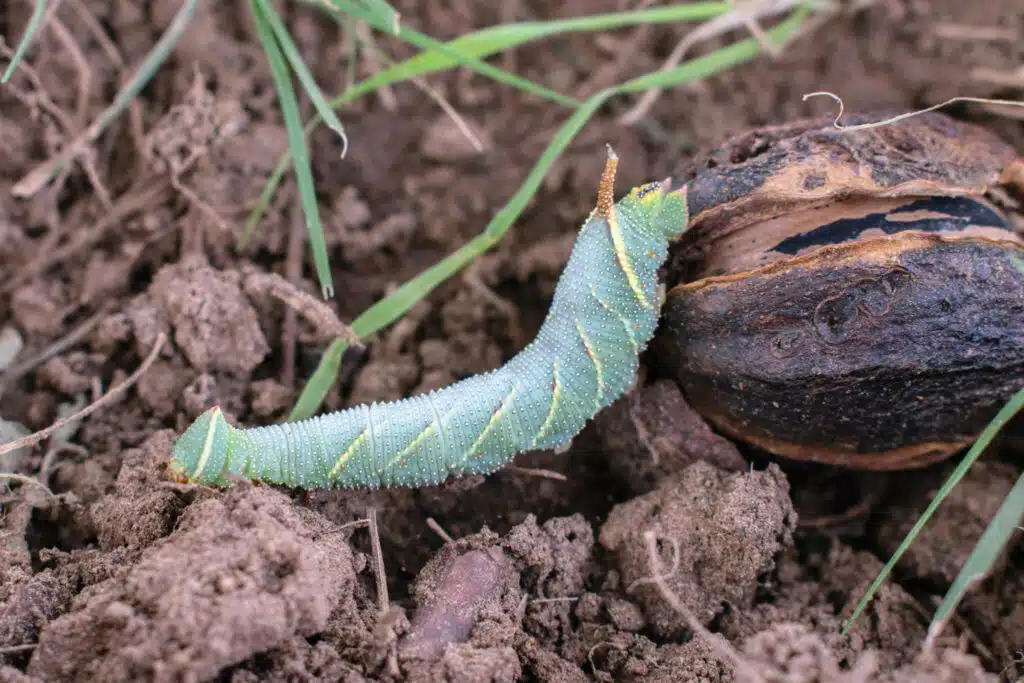
A green-blue color is specific to the mature Walnut Sphinx Caterpillar (Amorpha juglandis). This is a green species at first, in its early growth stages.
Light blue shades appear on its dorsal side with yellow stripes appearing on its lateral sides as the species grows.
The status of the caterpillar is negligible but it may become a pest in given areas.
This species feeds on walnut, hazelnut, and alder leaves, with an associated risk of becoming a pest on poorly managed hazelnut and walnut plantations.
Walnut Sphinx Caterpillar feeds constantly as the adult moth doesn’t eat at all.
Caterpillars of this family are seen all around Eastern North America.
They first appear in May with a potential for becoming a pest from June to August in periods of drought.
2. Regal Moth Caterpillar
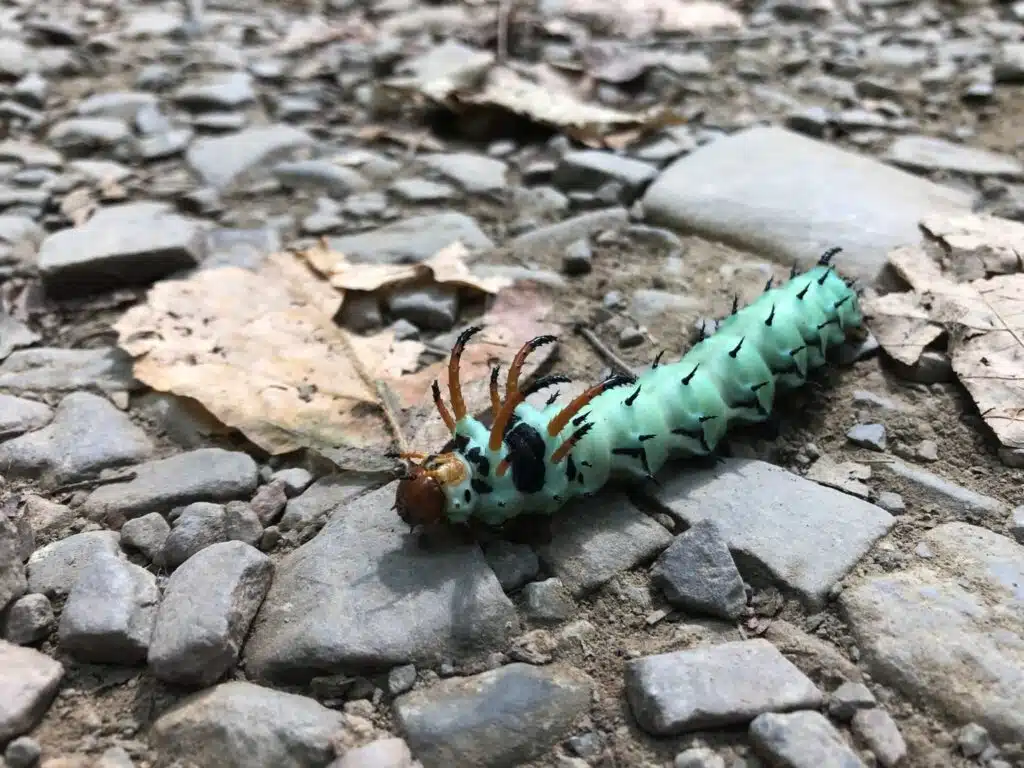
Regal Moth Caterpillars (Citheronia regalis) are among the largest types of caterpillars in the world.
This species is known for reaching a size of up to 4.9 inches which makes it even 3 times longer than other common caterpillars.
Regal Moth Caterpillars are also known for turning green-blue in their later growth stages from an initial brown color.
These caterpillars need to be addressed as potential pests on walnut, hazelnut, and hickory.
Damages are typically small as they only get to consume a small amount of host tree leaves before being predators.
Tachinid flies and predatory wasps are the most common predators of the species.
Even if they make it to maturity and form a pupa, these types of caterpillars might still be predated by multiple species of tachinid flies.
3. Cecrops Eyed Silkmoth Caterpillar
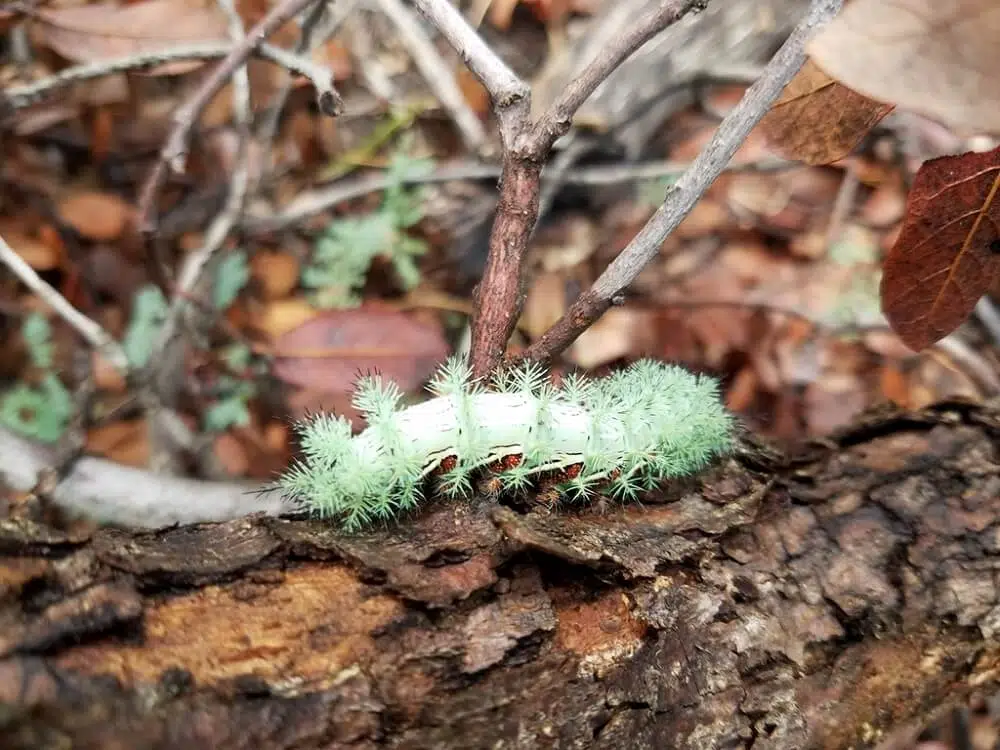
This is the caterpillar of the Cecrops Eyed Silkmoth (Automeris cecrops), a species known for having eyespots as large as the hindwings, mainly used to keep predators away.
Caterpillars of this species have different coloring, mainly a combination of green and blue as they reach maturity.
Green-blue and black spikes are also seen covering its body.
Woodlands and scrub habitats are among the preferred areas of these caterpillars.
Host species include trees and flowers.
Various types of oak leaves provide food for the species, as Cecrops Eyed Silkmoths don’t feed.
Deer brier or Fendler ceanothus is the main host of the species. This is a shrub known for its multiple spines that turn flowers, a look also specific to the spiny Cecrops Eyed Silkmoth Caterpillar.
4. Cecropia Moth Caterpillar
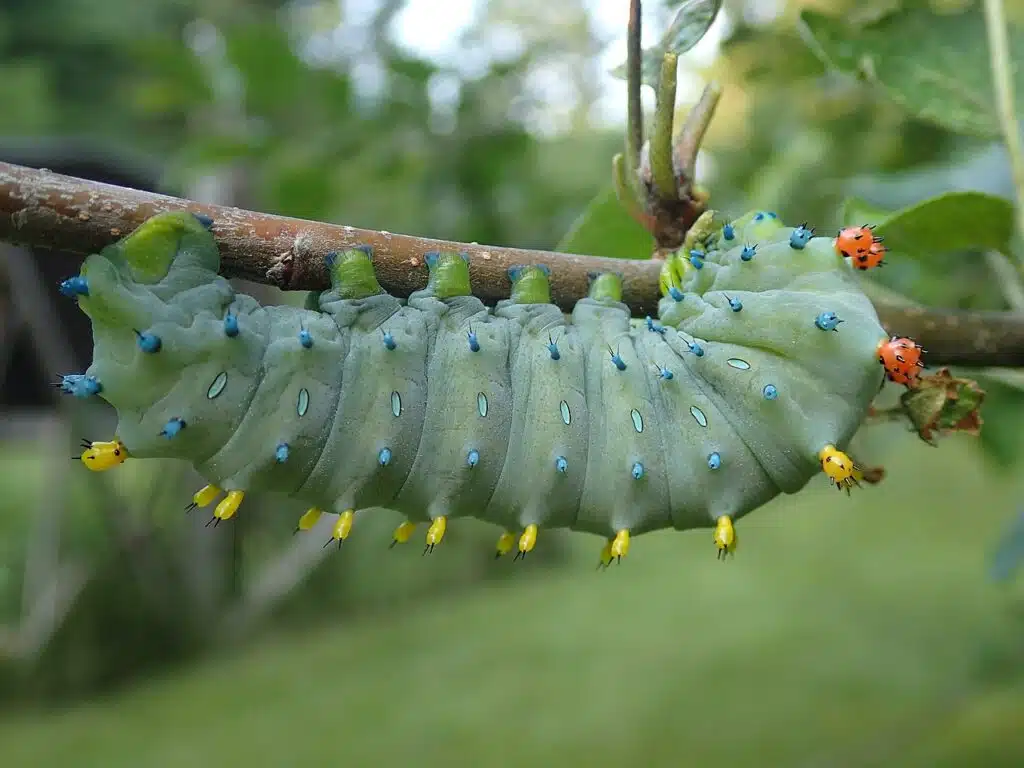
This type of caterpillar (Hyalophora cecropia) is known for changing colors as it grows.
Its initial color is brown or even black. The caterpillar later brightens to a green-blue color from the 3rd instar and into the final 5th instar.
The species also grows blue or orange tubercles. Some caterpillars have both blue and orange tubercles in the 5th instar.
These cover both the central dorsal area and the sides of the body.
Beech, hemp, and rose bushes are all potential hosts of the species.
Cecropia Moth Caterpillars don’t pose a major threat to any of these host plants or trees.
Wasps are among the most common predators of the species which further keeps the populations under control.
Once an adult, the Cecopia Moth stops feeding as it doesn’t have usable mouthparts and only survives 10-14 days.
5. Promethea Silkmoth Caterpillar
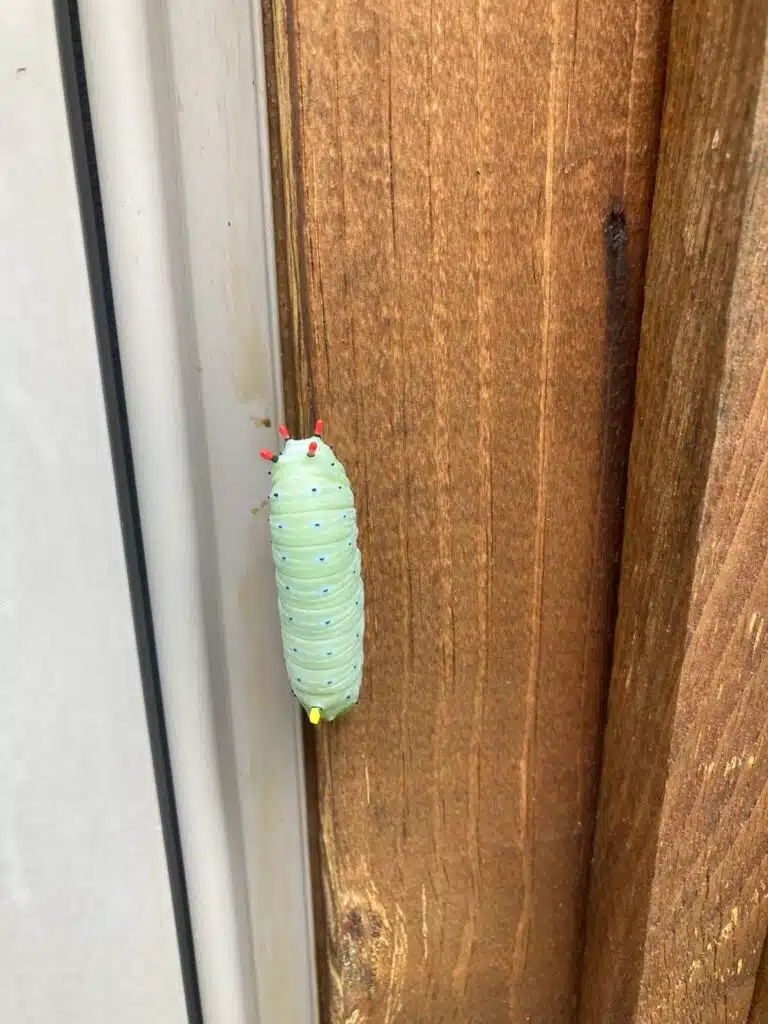
Spicebush is among the common hots of the Promethea Silkmoth Caterpillar (Callosamia promethea).
With a reduced impact, the caterpillar species doesn’t hold a pest status across most of its natural habitats.
The species is known to begin life as yellow eggs, which show brown spots just before hatching.
The emerged caterpillar has a yellow and brown color which changes as it grows.
A blue-green color is specific from the 3rd instar and into the final 5tg instar.
Contrasting red marks or protuberances are specific to this species into its late growth stages.
The emerged adult holds the color of the early growth stage caterpillar as it has various shades of brown and tan colors.
6. Ilia Underwing Caterpillar
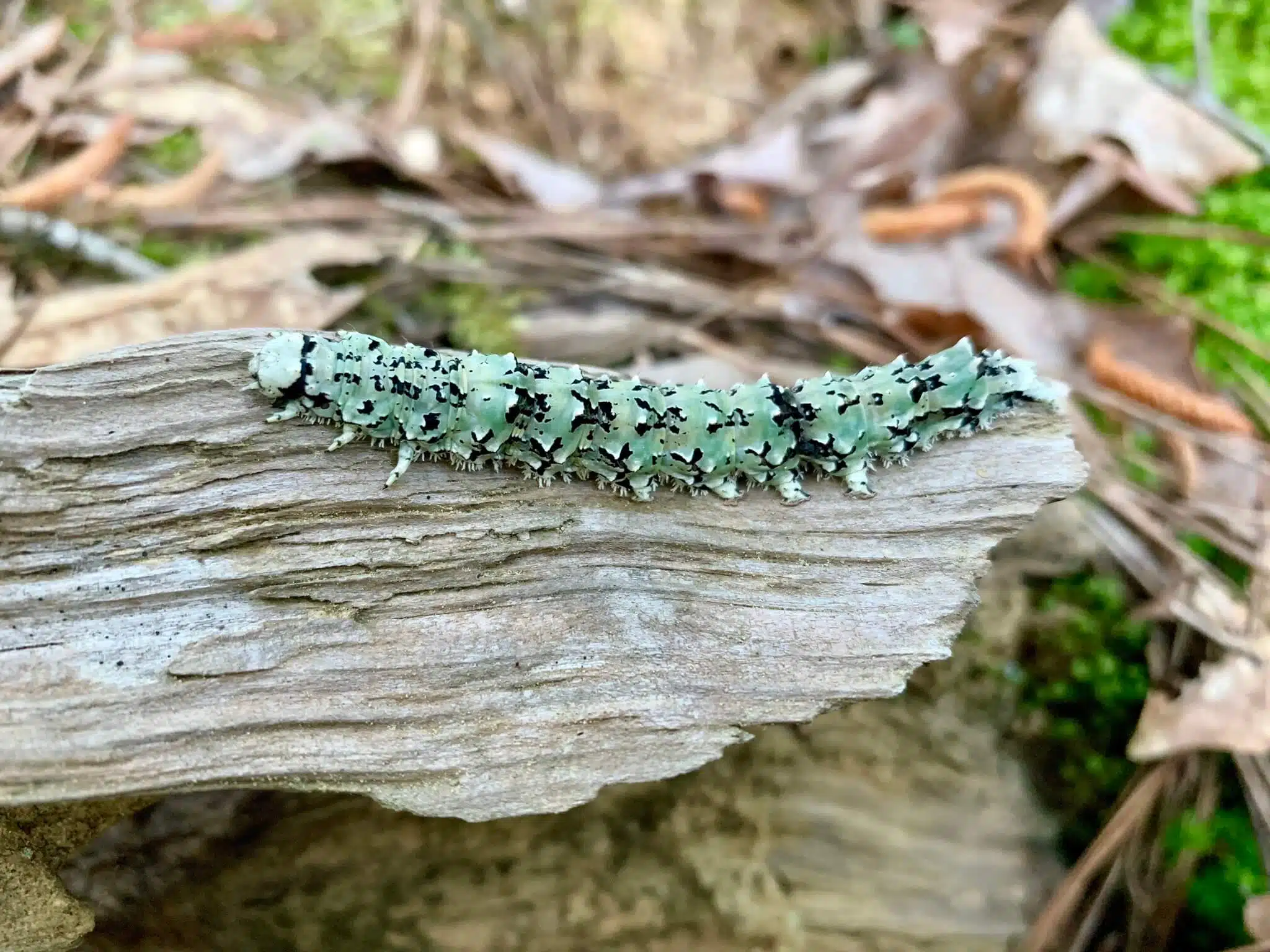
Ilia Underwing Caterpillars (Catocala ilia) have no common coloring with the moths of the species.
These caterpillars have a blue-green color with pink to red ventral coloring and black marks across the body.
Native to Eastern US states, this is a species that already starts to grow in its habitat West of The Rocky Mountains.
The species see woodlands as a good habitat. It feeds on oak tree leaves.
Red and white oaks are among its favorites. While they like to consume leaves, they aren’t major oak pests.
Handpicking these caterpillars from backyard oak trees proves more difficult as the color of the species helps them blend in with tree bark.
Once an adult, this species may become easier to spot based on its orange and black stripes on the hindwings.
7. Columbia Silk Moth Caterpillar
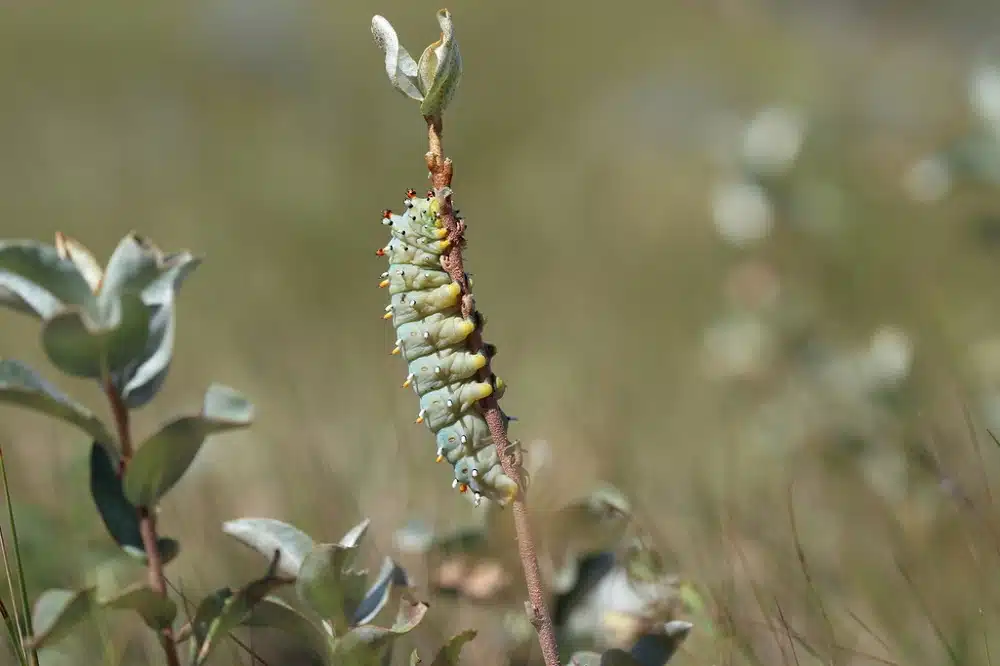
Eastern larch, also known as American larch, is the main host plant of Columbia Silk Moth Caterpillars (Hyalophora columbia).
Alder is another common host for this species which is found both across Eastern US and Eastern Canada.
Columbia Silk Moth Caterpillars are marked by a green-blue color.
The species has a bright green color in its early days, slowly turning green-blue as it matures.
Once it pupates, the Colombia Silk Moth has no green or blue coloring.
This is a mostly gray and brown species. Its underwings have a gray color while the body has rare white and brown bands and stripes.
8. Jeweled Tailed Slug Moth Caterpillar
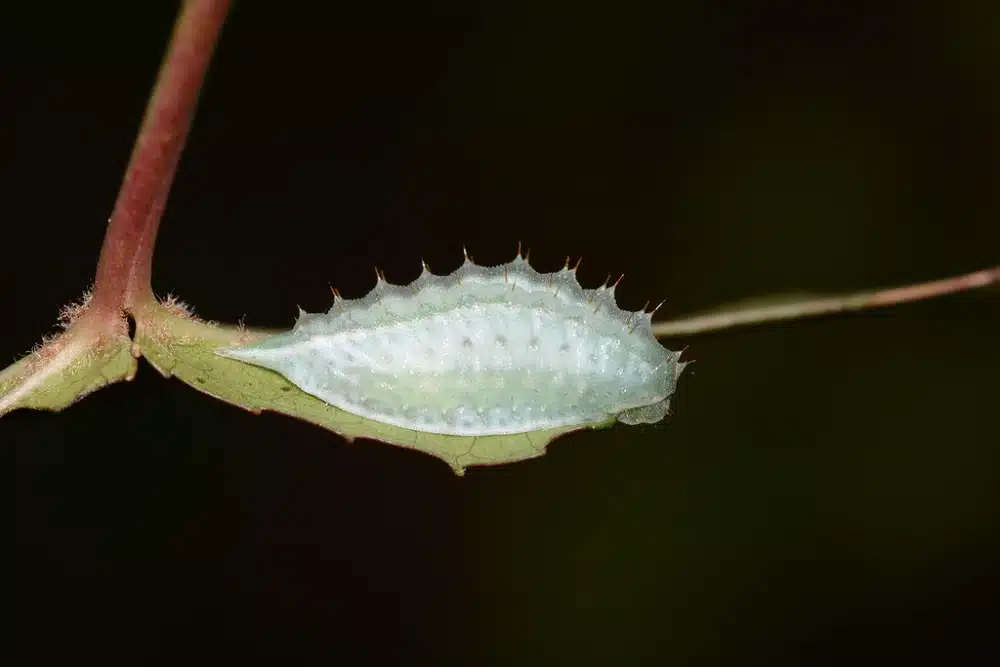
A base white color is first specific to the Jeweled Tailed Slug Moth Caterpillar (Packardia geminata). The species turns blue-green as it grows.
These types of caterpillars look similar to slugs. An elongated oval body makes some predators overlook the species.
Various species of hardwood trees are specific hosts of this slug-like caterpillar.
Oak and hickory are the most common hardwood hosts of the species.
Damages to these trees can be seen as considerable in case of invasions. These caterpillars tunnel their way through the host tree, under tree bark.
9. White-dotted Prominent Caterpillar
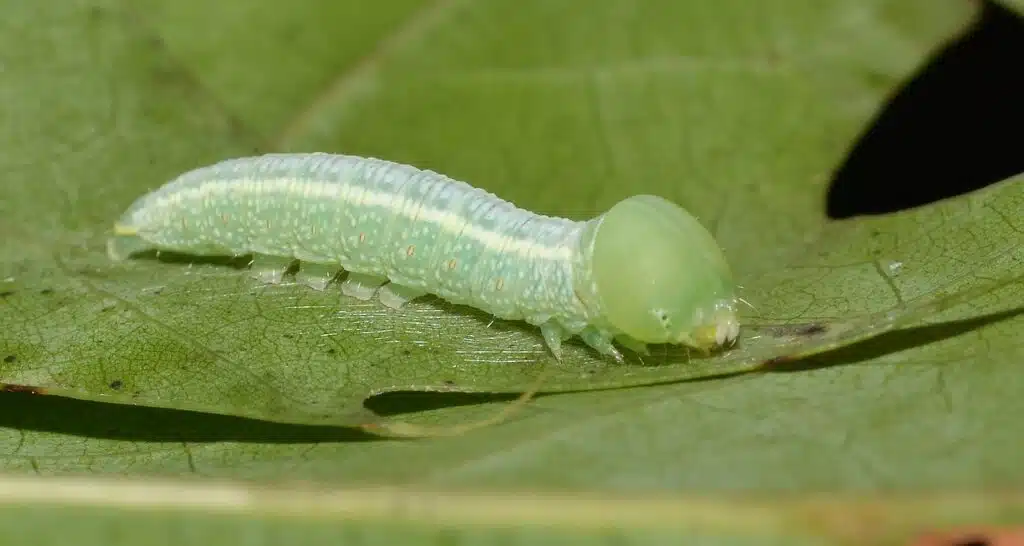
White-dotted Prominent Caterpillars (Nadata gibbosa) are among the atypical blue caterpillars.
It has a blue-green color and it turns green as it grows unlike other types of caterpillars that turn blue as they mature.
The species has yellow lateral bands and tiny yellow dots across the body.
Oaktree leaves represent the diet of the White-dotted Prominent Caterpillar.
Oak woodlands are the most common habitat of the White-dotted Prominent Caterpillar.
As the adult moth, the species may show both nocturnal and diurnal activity.
10. Forest Tent Caterpillar Moth Caterpillar
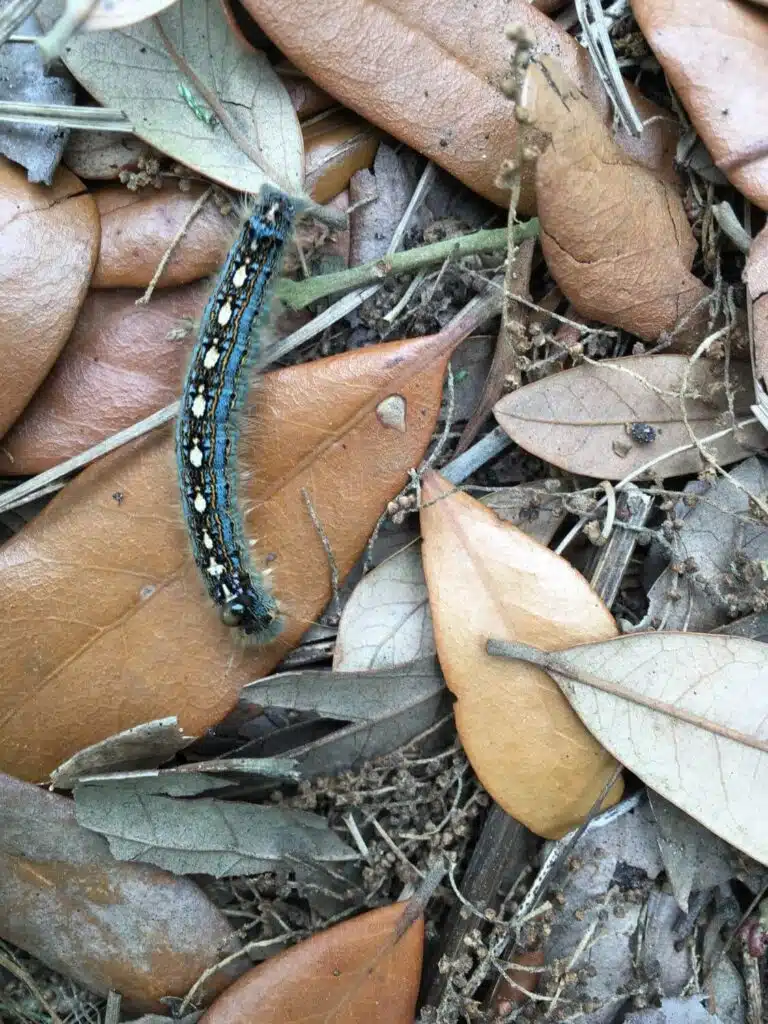
Forest Tent Caterpillar Moth Caterpillars (Malacosoma disstria) have clear blue coloring in the form of stripes.
Black, orange and white coloring is also specific to the species.
These types of caterpillars use silk to move around freely on the host tree.
It can be difficult for the caterpillars to create silk in the first instars and this is why they’re grouped in their first days of the lifecycle.
They share the same silk paths when they first appear. Some Forest Tent Caterpillar Moth Caterpillars may sometimes fail to properly move without silk.
Falling off the host tree is common whenever young caterpillars aren’t able to either produce or use shared silk pathways on the host tree.
11. Spun Glass Slug Moth Caterpillar
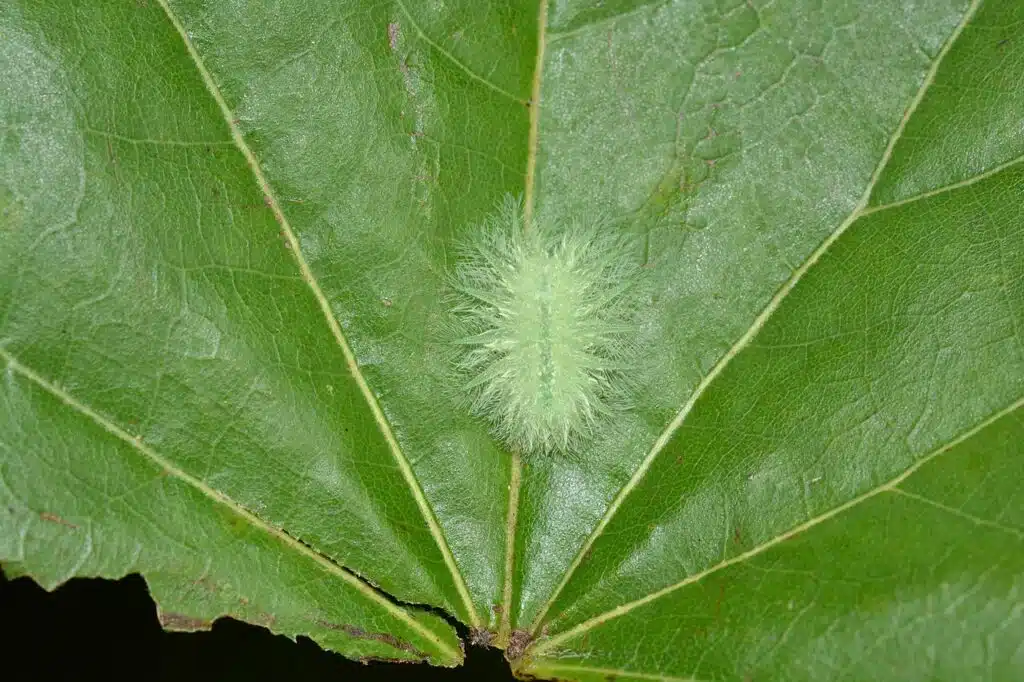
Spun Glass Slug Moth Caterpillars (Isochaetes beutenmuelleri) have a green and a green-blue color.
This species is among the few that have poison glands. Handling these caterpillars may lead to dermatitis, as a result.
Various hardwood woodlands are the ideal habitat for the species.
These caterpillars feed on oak tree leaves, known for their lush green color which acts to the camouflaging advantage of the green-blue caterpillar.
Beech is another common host for the species. These caterpillars aren’t major pests to either oak or beech.
They change to brown and gray colors as they emerge as moths.
12. Spiny Oak-slug Moth Caterpillar
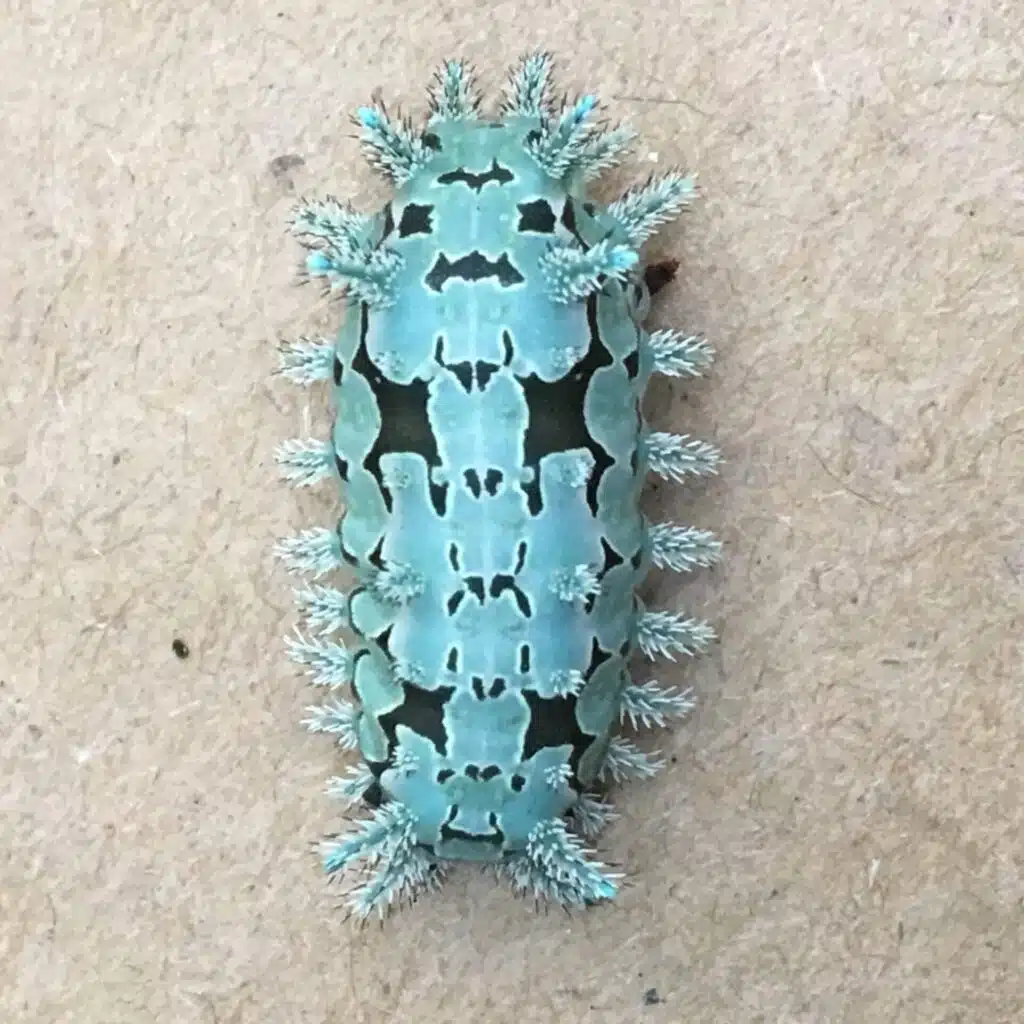
A spiny body inspires the name of the Spiny Oak-slug Moth Caterpillar (Euclea delphinii).
This is a common species of caterpillar with a multi-colored body.
The species is also known for going through different color changes. Some of these changes include periods when the spines have a different color to the body as they can also be yellow.
Blue marks at the base of the spines are also seen just before the species enters its final growth stages.
Spiny Oak-slug Moth Caterpillars feed on oak, ash, and apple. Blueberry is also a common host for the species in North America.
13. Abbott’s Sphinx Caterpillar
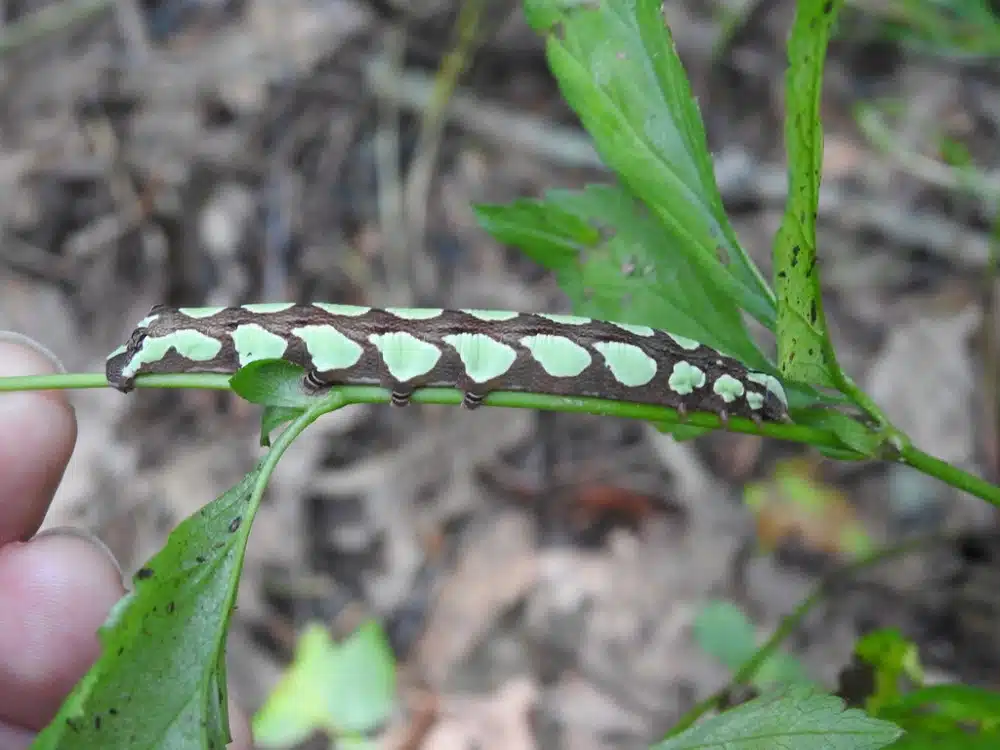
Much of the life of Abbott’s Sphinx Caterpillars (Sphecodina abbottii) are marked by their coloring which makes them blend in with the environment.
Both caterpillars and adult moths of the species are known for their camouflaging colors.
A dark green to blue body is specific to the caterpillar as it grows. It also shows brown colors, which are later seen in multiple nuances on the adult moths of the species.
The blue nuances of the species might be influenced by grapes vines and grapes, the most common host of the caterpillar.
This species is seen in multiple broods in Southern US states.
14. Franck’s Sphinx Caterpillar
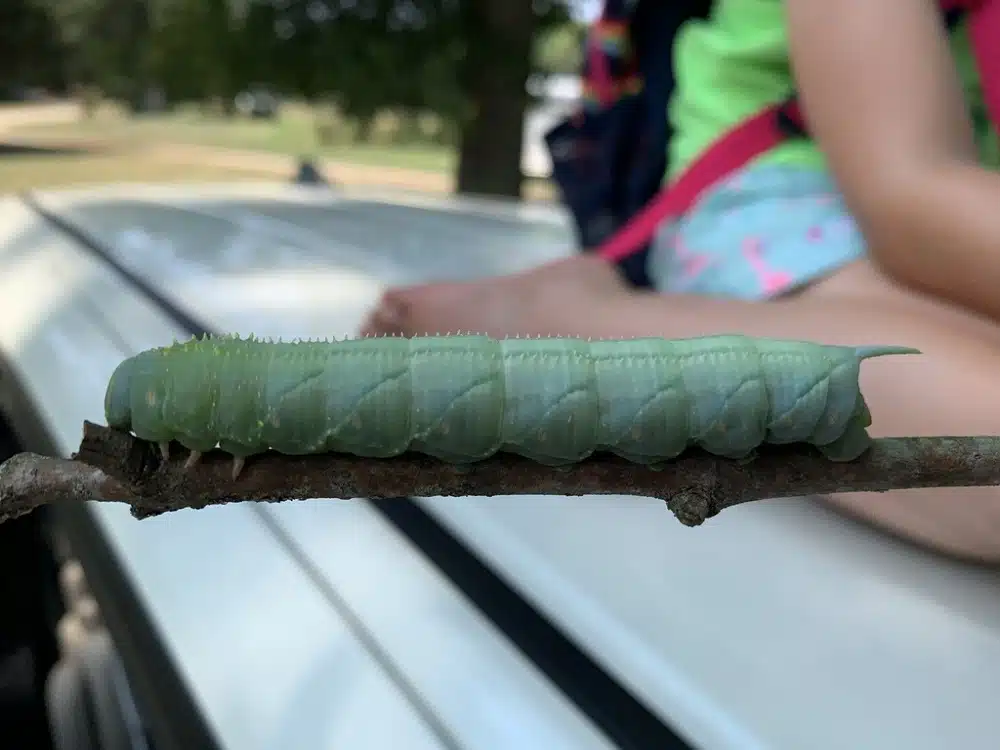
A pale green color turns to a blue-green color covering almost all of the body of this caterpillar (Sphinx franckii).
Its initial green stages are replaced by darker stages with blue undertones where the species also shows tiny yellow dots across its body.
This type of caterpillar is one of the rare sights on fringe trees and ash.
Some caterpillars are also seen on ornamental plants that might grow near homes, such as purple lilac.
With a wide habitat around the US, this species is also seen in multiple broods in the South, similar to Abbott’s Sphinx Caterpillar.
15. Calleta Silkmoth Caterpillar
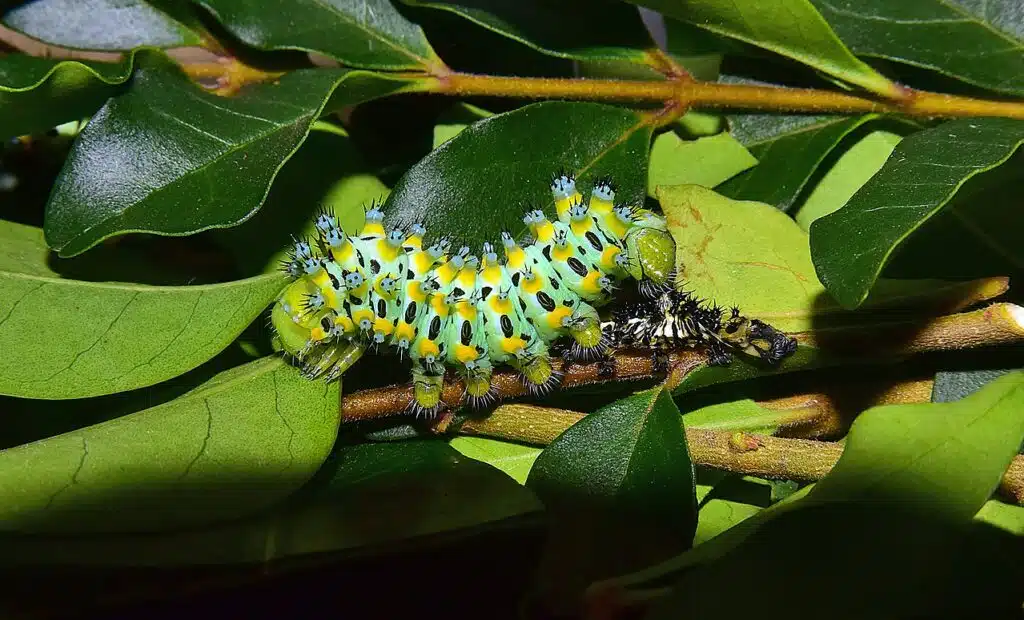
Arizona, New Mexico, and Texas are among the US states where the Calleta Silmoth Caterpillar (Eupackardia calleta) is most common.
This is a species of caterpillar that grows blue decorative spots on its body as it matures.
Tiny blue dots and tiny red dots make this species look poisonous to some of its predators.
Raccoons aren’t impressed by these colors as they are some of the most common Calletta Silkmoth Caterpillar predators.
Mexican jumping beans and hardwood trees are the hosts of the species.